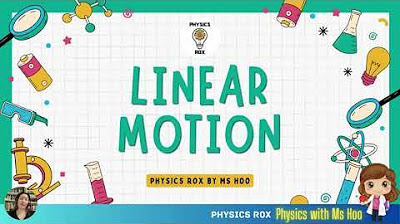Distance displacement speed velocity acceleration for IGCSE Physics, GCE O level Physics
Summary
TLDRThis video explains essential physics concepts such as distance, displacement, speed, velocity, and acceleration. It distinguishes between distance as a scalar quantity and displacement as a vector, highlighting their roles in motion. The video further elaborates on speed, including instantaneous and average speed, and defines velocity as speed in a specific direction. Acceleration is discussed as the change in velocity over time, along with its formula. Overall, it provides a clear understanding of how these fundamental concepts interrelate, serving as a valuable resource for students in their study of physics.
Takeaways
- 😀 Distance traveled by an object is the total length of the path, measured in meters, and is a scalar quantity without direction.
- 😀 Displacement is the shortest distance from the starting point to the endpoint, represented by the diameter of the circle in the example, and is a vector quantity with both magnitude and direction.
- 😀 Speed is defined as the distance traveled per unit time, measured in meters per second, and is a scalar quantity.
- 😀 Instantaneous speed refers to the speed at a specific moment, while average speed is the total distance divided by the total time.
- 😀 Velocity is speed in a given direction and is a vector quantity; it includes both magnitude and directional information.
- 😀 Acceleration is defined as the change in velocity per unit time and is also a vector quantity, with a unit of meters per second squared.
- 😀 The equation for acceleration is a = (V - U) / t, where 'a' is acceleration, 'V' is final velocity, 'U' is initial velocity, and 't' is time taken.
- 😀 Deceleration occurs when the final velocity is less than the initial velocity, indicating the object is slowing down.
- 😀 In straight-line motion, the magnitude of distance and displacement are equal, making speed and velocity the same.
- 😀 The equations provided for speed, average speed, and acceleration are applicable under specific conditions, such as constant speed or constant acceleration.
Q & A
What is the difference between distance and displacement?
-Distance is the total length of the path traveled by an object, measured as a scalar quantity with only magnitude. Displacement, on the other hand, is the directed distance from the starting point to the endpoint, making it a vector quantity that includes both magnitude and direction.
How is speed different from velocity?
-Speed is the distance traveled per unit of time and is a scalar quantity, meaning it only has magnitude. Velocity, however, is speed in a given direction, making it a vector quantity that includes both magnitude and direction.
What are the units for distance, displacement, speed, and velocity?
-All four quantities—distance, displacement, speed, and velocity—are measured in meters (m). Speed and velocity are specifically expressed in meters per second (m/s).
What is the significance of instantaneous speed?
-Instantaneous speed refers to the speed of an object at a specific moment in time. It is different from average speed, which is calculated over a period of time. For example, if a car's speedometer shows 80 kilometers per hour, that represents the instantaneous speed.
What does acceleration measure?
-Acceleration measures the change in velocity per unit of time and is a vector quantity. It indicates how quickly an object is speeding up or slowing down, with units expressed in meters per second squared (m/s²).
How can you determine if an object is decelerating?
-An object is decelerating if its final velocity is less than its initial velocity, resulting in a negative acceleration. This indicates that the object is slowing down.
What equation is used to calculate average speed when acceleration is constant?
-The equation used to calculate average speed when acceleration is constant is (U + V) / 2 = D / t, where U is initial speed, V is final speed, D is total distance, and t is time taken.
What is the equation for acceleration?
-The equation for acceleration is a = (V - U) / t, where 'a' is acceleration, 'V' is final velocity, 'U' is initial velocity, and 't' is the time taken.
What is the difference between constant speed and average speed?
-Constant speed refers to maintaining the same speed throughout the motion, resulting in zero acceleration. Average speed, however, is calculated by dividing the total distance traveled by the total time taken, which may vary if the speed changes during the journey.
How is instantaneous acceleration determined when it is not constant?
-Instantaneous acceleration, when not constant, can be found from the gradient of the tangent line of a speed-time graph. This provides a snapshot of how acceleration changes at a specific point in time.
Outlines

Dieser Bereich ist nur für Premium-Benutzer verfügbar. Bitte führen Sie ein Upgrade durch, um auf diesen Abschnitt zuzugreifen.
Upgrade durchführenMindmap

Dieser Bereich ist nur für Premium-Benutzer verfügbar. Bitte führen Sie ein Upgrade durch, um auf diesen Abschnitt zuzugreifen.
Upgrade durchführenKeywords

Dieser Bereich ist nur für Premium-Benutzer verfügbar. Bitte führen Sie ein Upgrade durch, um auf diesen Abschnitt zuzugreifen.
Upgrade durchführenHighlights

Dieser Bereich ist nur für Premium-Benutzer verfügbar. Bitte führen Sie ein Upgrade durch, um auf diesen Abschnitt zuzugreifen.
Upgrade durchführenTranscripts

Dieser Bereich ist nur für Premium-Benutzer verfügbar. Bitte führen Sie ein Upgrade durch, um auf diesen Abschnitt zuzugreifen.
Upgrade durchführenWeitere ähnliche Videos ansehen

Linear Motion - Distance, Displacement, Speed, Velocity, Acceleration - SPM & IGSCE Physics

Kinematics in 1 dimension part 1

BAB 4 : GERAK DAN GAYA | Part 1 : GERAK BENDA | IPA SMP Kelas 7 Kurikulum Merdeka

FISIKA KELAS X: GERAK LURUS (PART 1) Jarak, Perpindahan, Kelajuan, Kecepatan, Percepatan

IGCSE Physics [Syllabus 1.2] Motion

Cinemática no Cotidiano
5.0 / 5 (0 votes)
